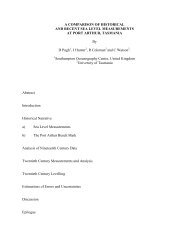Oceans Program
Oceans Program
Oceans Program
You also want an ePaper? Increase the reach of your titles
YUMPU automatically turns print PDFs into web optimized ePapers that Google loves.
The Southern Ocean and Sea-Level Rise<br />
1. Overview of the program + who’s involved<br />
2. Plans for contributing to IPCC 5 th Assessment
Evolving state of the Southern Ocean<br />
1. How is the Southern Ocean changing?<br />
2. What is the impact of changes in ocean<br />
circulation and water properties on the<br />
cryosphere, biogeochemical cycles and biology<br />
of the Southern Ocean?<br />
3. What is the cause of observed changes in<br />
the Southern Ocean? How much of the signal is<br />
consistent with anthropogenic climate change?
Research plan: Fieldwork<br />
Argo, including ice floats<br />
Moorings: Mertz polynya region and Antarctic<br />
margin near Casey<br />
Repeat hydrographic + tracer sections<br />
• Dec 2010: southern end of SR3 + shelf/slope<br />
• Feb 2012: recover 115E moorings<br />
• Jan 2013: Mertz area, on Tangaroa<br />
• I9S (115E): 2011-12? Or 2014?
Modelling and synthesis<br />
Analyse output from heirarchy of models, from<br />
regional high-resolution to global coarseresolution<br />
climate models.<br />
Detection – attribution studies.
Who’s involved?<br />
ACE + local partners:<br />
•Steve Rintoul<br />
•Nathan Bindoff<br />
•Serguei Sokolov<br />
•Mark Rosenberg<br />
•2 new hires (physical oceanographers)<br />
•Students<br />
International:<br />
•Eberhard Fahrbach (AWI, Germany)<br />
•Shigeru Aoki (ILTS, Japan)<br />
•Rosemary Morrow (LEGOS, France)<br />
•Mike Williams (NIWA, NZ)<br />
•Weidong Yu (FIO, China)
ACE Science for IPCC 5 th Assessment (AR5)<br />
Strategy:<br />
• Nominate for lead author positions<br />
• Focus our effort on high impact science relevant to AR5
IPCC <strong>Oceans</strong> chapter outline<br />
Chapter 3: Observations: Ocean<br />
• Changes in ocean temperature and heat content<br />
• Ocean salinity change and freshwater fluxes<br />
• Sea level change, ocean waves and storm surges<br />
• Ocean biogeochemical changes, including ocean<br />
acidification<br />
• Changes in ocean surface processes<br />
• Changes in ocean circulation<br />
• Spatial and temporal patterns of ocean variability
Future of the overturning circulation<br />
Rintoul, 2001
Overturning circulation acts as a valve regulating<br />
exchange between atmosphere and deep sea<br />
Sigman et al.,<br />
Nature, 2010
Water mass changes:<br />
freshening of Antarctic Bottom Water<br />
neutral density<br />
salinity
Warming of the abyssal ocean<br />
Purkey and Johnson, 2010
Warming of deep North Pacific caused by<br />
change in air-sea flux in East Antarctica?<br />
Masuda et al., Science, 2010
Kerguelen Deep Western Boundary Current<br />
Experiment: Australia - Japan<br />
12 Sv ± 1.2 Sv of AABW ( 20 cm s -1 .<br />
Fukamachi et al.,<br />
Nature Geoscience,<br />
2010
Ekman, eddies and mean flow all contribute to<br />
transfer of water between the surface and interior<br />
Sallée et al 2009
Subduction hot-spots
Subduction hot-spots and distribution of potential<br />
vorticity and anthropogenic CO 2<br />
PV on γ = 26.8<br />
C anthrop on γ = 26.8<br />
Red: subduction<br />
Color: PV (yellow is low)<br />
Sallee, Speer, Rintoul + Wijffels, JPO, 2009<br />
green: subduction<br />
yellow: upwelling<br />
Color: C_ant (red is high)
Sallee, Speer, Rintoul, Nature Geoscience, 2010<br />
Structure and variability of the mixed layer<br />
Seasonal<br />
variations in<br />
mixed layer<br />
depth<br />
Variations in<br />
mixed layer<br />
depth with the<br />
Southern<br />
Annular Mode<br />
SAM + SAM -
Response of upper limb of overturning to climate<br />
change<br />
Downes, Bindoff & Rintoul, 2010
Can IPCC models parameterise the effect of<br />
eddies?<br />
Sallée & Rintoul, in prep
Yes, if you use the right coefficient (which no<br />
one does)
Trends in sea surface height: 1992-2007<br />
Sokolov and Rintoul, JGR-<strong>Oceans</strong> 2009a,b
Southward shift of ACC fronts<br />
Change in latitude of fronts (degrees)<br />
Sokolov and Rintoul, JGR, 2009<br />
year
Diagnosing the causes of SO change<br />
Air-sea flux<br />
Southward<br />
shift of fronts<br />
Sum<br />
Sum from a<br />
different<br />
analysis<br />
Meijers et al., sub.
Loss of Antarctic ice: melt by a warmer ocean?<br />
Antarctic mass<br />
loss increased by<br />
70% in last<br />
decade, as a result<br />
of warmer air and<br />
sea temperatures.<br />
Rignot et al., Nature<br />
Geoscience, 2008
East Antarctica more vulnerable than expected?<br />
Fox, Science, 2010
Quantifying basal melt potential with elephant<br />
seal data<br />
Cross-shelf intrusions of warm<br />
MCDW observed near Budd<br />
Glacier (109E) and Dibble Ice<br />
Tongue (135E).<br />
Bestley, Rintoul and Charassin, in prep
Basal melt rates vs. temperature elevation above<br />
freezing point temperature at grounding line<br />
Bestley, Rintoul and Charassin, in prep
Massom et al., 2001
With additional<br />
support from<br />
The Southern Ocean<br />
Observing System<br />
(SOOS)<br />
www.scar.org/soos
Summary<br />
<strong>Oceans</strong> program making good progress.<br />
Strategy for IPCC in place:<br />
• Lead authors<br />
• Target effort at key uncertainties:<br />
• Overturning circulation (upper and lower limb)<br />
• Ocean change (shallow and deep)<br />
• Ocean – ice interaction<br />
• Modes of variability<br />
• Detection and attribution<br />
• Model improvements<br />
• Marine impacts
Mawson meets Scott<br />
The Monthly, July 2010
Andrew Meijers
EAST-WEST 5<br />
Andrew Meijers + Ben Galton-Fenzi
B09B<br />
C28<br />
MGT<br />
15-03-2010 (TerraSAR-X)
Measuring the ACC flow through gaps in the<br />
Macquarie Ridge
Measuring the ACC flow through gaps in the<br />
Macquarie Ridge<br />
Strong barotropic<br />
flow in the branch of<br />
the Subantarctic<br />
Front passing<br />
through the 50 km<br />
wide gap north of<br />
Macquarie Island.<br />
Mean transport of<br />
57.0 ± 8.5 Sv.
Injection of Subantarctic Mode Water<br />
Herraiz-Borreguero + Rintoul, subm








